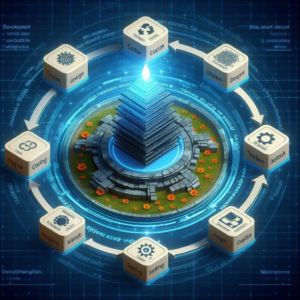Program Transformation: Life Cycle Models and Environments
1. Introduction
Program transformation is a pivotal concept in software engineering. It focuses on the systematic modification of program code to improve its structure, performance, or maintainability without altering its external behavior. This process is crucial in evolving software systems as requirements change over time, necessitating updates to the underlying codebase. Transformations can be applied at various stages of the software lifecycle, ensuring the code adapts to new needs. Techniques include refactoring, optimization, and formal methods
2. Life Cycle Models in Program Transformation
The life cycle of software development traditionally follows a structured model. This model can be broken down into several phases: requirements analysis, design, implementation, testing, deployment, and maintenance. Each phase of the software lifecycle can benefit from program transformation techniques. These techniques ensure that the software remains adaptable and efficient throughout its entire lifecycle.
Requirements Analysis
During this phase, program transformation can assist in refining requirements. Techniques such as model checking ensure that the requirements are consistent and complete. This is crucial before moving to the design phase.
Design
In the design phase, transformations can help generate design models from requirements. For instance, transformation rules can convert high-level specifications into detailed design artifacts. This ensures the design aligns with the intended functionality.
Implementation
The implementation phase involves translating design models into executable code. Program transformation techniques, such as code generation and synthesis, can automate this process. This reduces the likelihood of human error and improves consistency across the codebase.
Testing
Testing is critical for ensuring software quality. Program transformation can aid in generating test cases from specifications. This ensures that all aspects of the software are covered. Moreover, transformations can optimize test suites by removing redundant tests or combining similar cases.
Deployment
The deployment phase also benefits from transformations. This is particularly important in adapting software to different environments or platforms. Transformations may include generating configuration files or adapting code to meet specific deployment requirements.
Maintenance
Finally, maintenance is where program transformation shines. As software evolves, transformations help refactor code. This improves readability and maintainability. They can also optimize performance or adapt to new requirements without introducing bugs.
3. Environments for Program Transformation
The environments in which program transformations occur play a significant role in their effectiveness. These environments can be categorized into several types:
Integrated Development Environments (IDEs)
Modern IDEs provide tools for program transformation, including refactoring support, code analysis, and automated testing. These tools help developers apply transformations seamlessly within their workflow, optimizing the software lifecycle and ensuring efficient development, testing, and maintenance.
Formal Methods Environments
Formal methods provide a rigorous foundation for program transformation. Developers can specify transformations mathematically. Tools that support formal verification ensure that transformations preserve desired properties of the software.
Model-Driven Development (MDD) Environments
MDD emphasizes the use of models as primary artifacts in software development. In these environments, transformations are applied to models rather than code. This allows for higher-level abstractions and automated code generation.
Continuous Integration/Continuous Deployment (CI/CD) Environments
CI/CD practices emphasize automation in the software development life cycle. Transformations can be integrated into CI/CD pipelines. This ensures that code is continuously tested, built, and deployed, allowing for rapid iterations.
Cloud-Based Development Environments
With the rise of cloud computing, development environments have shifted to the cloud. These environments provide scalable resources for executing transformations and enhance the software lifecycle with collaborative tools for teams working on the same codebase.
4. Challenges in Program Transformation
While program transformation offers numerous benefits, it presents several challenges:
Complexity of Transformations
Designing effective transformation rules can be complex, particularly in large codebases. Developers must ensure that transformations align with the software lifecycle, maintaining consistency and preventing errors throughout the development process.
Tool Support
The availability of tools to support program transformation varies widely. Some IDEs offer robust refactoring tools, while others may lack necessary features.
Resistance to Change
Developers may resist applying transformations. This is due to concerns about introducing bugs. Additionally, the time required to refactor code can be a barrier.
Performance Overhead
Some transformations may introduce performance overhead. This is particularly true if they involve complex computations. Developers must evaluate the trade-offs between improved maintainability and performance.
Integration with Existing Processes
Integrating program transformation techniques into existing development processes can be challenging. Organizations must ensure that transformations align with their workflows and the software lifecycle, ensuring seamless adaptation across all stages of development.
5. Future Directions in Program Transformation
As software systems continue to evolve, the field of program transformation is likely to see advancements:
Automated Transformation
The future will likely see increased automation in program transformation, with tools that automatically apply transformations based on predefined rules throughout the software lifecycle. This reduces the burden on developers and enhances efficiency in the development process.
AI and Machine Learning
Integrating AI and machine learning can enhance program transformation processes. These technologies can analyze code patterns and recommend refactoring opportunities.
Integration with DevOps Practices
As DevOps practices become more prevalent, program transformation techniques will need integration into DevOps pipelines. This ensures transformations are applied consistently.
Support for New Programming Paradigms
As new programming paradigms emerge, program transformation techniques will need to adapt. This support will be essential for effectively applying these paradigms.
Enhanced Tooling
The development of more sophisticated tools for program transformation will facilitate adoption throughout the software lifecycle. These tools will provide intuitive interfaces and robust support for various programming languages, streamlining development and enhancing efficiency.
6. Conclusion
Program transformation is a critical aspect of modern software development. It enables developers to maintain and evolve software systems effectively throughout the software lifecycle. By understanding life cycle models and environments, developers can leverage these techniques, including Python-based automation tools, to improve software quality and adaptability. Embracing AI and new paradigms will be essential for maximizing benefits in the future.
Do you like to read more educational content? Read our blogs at Cloudastra Technologies or contact us for business enquiry at Cloudastra Contact Us
